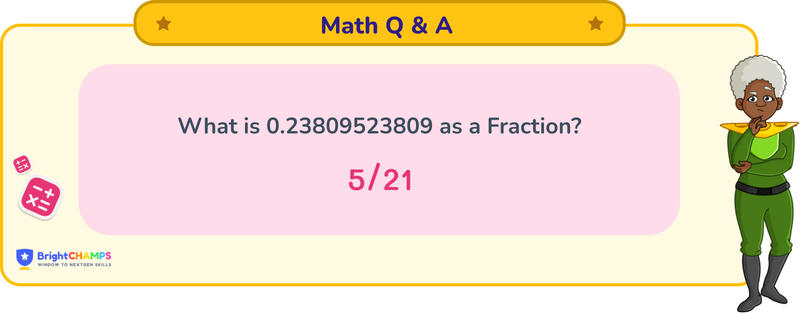Summarize this article:
 164 Learners
164 LearnersLast updated on August 5, 2025
0.23809523809 as a Fraction

Numbers can be categorized into different types, and fractions are one such type. A fraction is always represented in the form of p/q, where p is the numerator and q is the denominator. Fractions represent a whole and a fractional part. Decimals represent the fractional part of numbers. For example, 1/2. Numbers in decimal form are expressed with a decimal point (.), for example, 0.23809523809. We are going to learn how to convert a decimal to a fraction.

What is 0.23809523809 as a Fraction?

Answer
The answer for 0.23809523809 as a fraction is 5/21.
Explanation
Converting a decimal to a fraction is a straightforward task for students. You can follow the steps mentioned below to find the answer.
Step 1: Firstly, any decimal number should be converted to a fraction for easy calculation. Here, 0.23809523809 is the number on the numerator, and the base number 1 will be the denominator. Then, 0.23809523809 becomes 0.23809523809/1.
Step 2: To remove the decimal from a fraction, identify the repeating cycle. In this case, the repeating part is '238095', which is 6 digits long. Therefore, multiply both the numerator and the denominator by 10^6 to shift the decimal point. 0.23809523809/1 × 1000000/1000000 = 238095/1000000
Step 3: Now, simplify the fraction by finding the greatest common divisor (GCD) of 238095 and 1000000, which is 47619. Then divide the numerator and denominator by the GCD. 238095/1000000 = 5/21
Hence, 0.23809523809 can be expressed as the fraction 5/21.

Important Glossaries for 0.23809523809 as a Fraction
- Fraction: A numerical quantity that is not a whole number, representing a part of a whole.
- Decimal: A number that uses the base ten and includes a decimal point to separate the whole part from the fractional part.
- Numerator: The top part of a fraction, indicating how many parts of the whole are being considered.
- Denominator: The bottom part of a fraction, showing how many parts make up a whole.
- Repeating Decimal: A decimal in which a digit or group of digits repeats infinitely.

Explore More math-questions
![Important Math Links Icon]() Previous to 0.23809523809 as a Fraction
Previous to 0.23809523809 as a Fraction
![Important Math Links Icon]() Next to 0.23809523809 as a Fraction
Next to 0.23809523809 as a Fraction





